Dat Ass: The Disempowerment of the Strong Female Character through Sexual Objectification
Kate Beaton offers a hilarious summary of what I’ll be discussing in this comic. Check it out.
Now don’t get me wrong, I am a true believer that the ownership of one’s sexuality is truly empowering. But what I’m going to argue today is that by objectifying even the strongest, most independent characters can and are disempowered by the use of scintillating camera angles and poor character design choices. And by poor design choices I am referring to gaming’s tendency to create impractical armor and costumes for women that is more about being sexy than actually serving any practical purpose.
Check out: http://repair-her-armor.tumblr.com/ for some great examples of artists cleaning up some of these poor designs.
I should make a quick definition about what I mean by objectifying. As Barbara Fredrickson and Tomi-Ann Roberts, in their article Objectification Theory, they posit that girls and women are typically acculturated to internalize an observer’s perspective as a primary view of their physical selves. This perspective on self can lead to habitual body monitoring, which, in turn, can increase women’s opportunities for shame and anxiety, reduce opportunities for peak motivational states, and diminish awareness of internal bodily states.
Now what I’m looking at here is video game characters, and their appearance has little impact on their own, artificial emotional state. Seeing as how it was fabricated by the same designers who allowed their problematic wardrobe/depiction to exist in the first place. Rather, I am looking at how the objectification of these women impacts our perception of what women in games should look like, their capabilities and what it tells us is that in order to be a successful heroine in games, a woman must first be sexually attractive.
I’m going to analyze how some lady character case studies, all of whom are BAMFs in their own right, becoming reduced to nothing more than eye candy thanks to disappointing game design choices.
Miranda Lawson (Mass Effect)
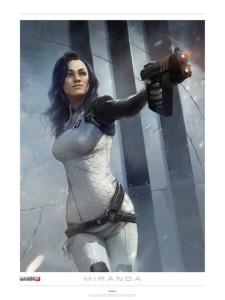
Miranda is a calculating, hardass Operative for the terrorist organization Cerberus who happens to be one of your first squadmates in Mass Effect 2. She’s also the inspiration for me writing this article thanks to this particular meme:
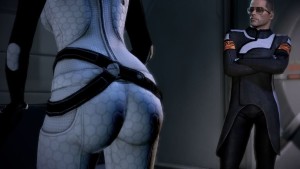
See, Miranda is an awesomely complex character with her own distinct motivations separate from you, Commander Shepard. Over the course of your interactions you’ll learn that she’s a genetically modified clone of her father, meant to be superior to everyday humans in every way, more intelligent, outliving the average human by at least half and she’s designed to be gorgeous. Which the game feels the need remind you several times to the point where we get scenes like this:
Miranda Lawson, when her showcasing her ass is more important then her sister.
Note how we never get to see Jacob (your other Cerberus Operative companion) bend over like that, despite the fact that he is a common counter argument to the hypersexulaized female characters in ME2. No, the developers objectively chose to feature these in game cut scenes with loving angles that depict Miranda’s butt in such a way. While one of the interesting facets of Miranda’s character is her simultaneous arrogance about her self and the deep rooted insecurity that she’s nothing outside of the gene modification that created her; these angles imply her fears are justified. Several times in game when she expresses her worries about herself or her sister, this is when the camera chooses to highlight her “assets” as if to say that even if she does have feelings, they are not nearly so important or intrinsic to her character as her appearance is. And on that note…
Lara Croft (Tomb Raider)
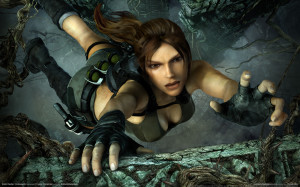
When someone mentions “games with a female lead,” most people probably think of Lara, or at least her franchise, Tomb Raider. Lara is kind of a funny example to examine, as she’s an example of one of the most prolific female characters in gaming who just so happens to be the poster girl for the male gaze as a Playboy centerfold.
Many people know about the myth surrounding her “legendary” chest size. The story goes that when developer Toby Gard went to increase Lara’s chest size 50%, his hand slipped and increased it 150%, what ensued was most likely an office joke that went a bit too far and ended up in the final version of the game. This is a female character to whom more attention is paid to the way in which she was physically designed rather then her story arc. Which is not uncommon for 1990s game stars, I mean what do we really know about Sonic?

But the thing about Lara is that she’s had several game spinoffs, that have blown into a full franchise and even had the 2013 remake of Tomb Raider, that delves deeper into Lara as a character. Which is great, except I’m going to pose a few questions: What motivates Lara Croft and why? Other than the fact that she’s British and a gun toting archaeologist, what sort of person is she? Is she nice? Is she a stone cold killer? Is she naive? Or is she the embodiment of male fantasy into an action hero that doesn’t allow for proper character development? These questions would have been at the very least difficult to answer were it not for this modern reboot of the franchise.

Which is why I do have more hope for the future after the most recent entrance into the franchise by Crystal Dynamics. This new younger Lara Croft appears a little more human in comparison to earlier versions, and her body has been streamlined into more realistic proportions. Marketing has her in physically powerful poses, rather than the low angle, down her shirt thing that Tomb Raider has been doing for years. Yes there is the ridiculous bits in the game where after massacring enemies for the past hour, Lara suffers the cold in her thin tank top despite sitting next to the downed body of a leather coat wearing bad guy. But the subject of power stances brings us to the next lady.
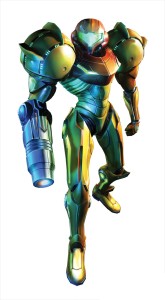
Samus Aran is a badass. I mean, just look at her. Look at that armor, look it how cool she is. Look at this gif:
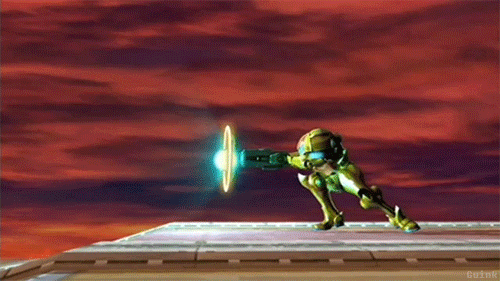
So cool! And she just so happens to be my go to character in Smash Bros, and as such, I wipe the floor with my enemies on a semi regular basis, but I digress.
The reveal back in 1986 at the end of Metroid that she is in fact a woman was stunning! You just went spelunking through several different levels on your own, shooting up aliens as lady the whole time. Awesome! So when she was included in Smash Bros we all knew for a fact that Samus was a lady and could smash her opponents into oblivion with her arm cannon, which is why it was a bit of a surprise, after 2 titles in the franchise, that Samus had an included ability to blow off her armor in Super Smash Bros Brawl and adopt her Zero Suit. Which is marketed like this:
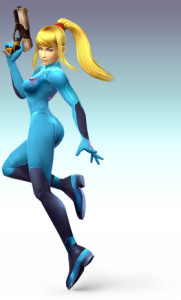
Nice spine configuration there Samus. Kind of looks like you broke your back. Neat. Check out Eschergirls for the reasons why this sort of posing is not so good: http://eschergirls.tumblr.com/
Keep in mind that I love Samus, I think she’s awesome. But part of interacting with media is being able to critically analyze it while still enjoying what you’re consuming. My primary beef is how they chose to represent Samus in Smash Bros Brawl. See Zero Suit Samus isn’t a selectable character, players still have to play as Power Suit Samus in order to gain access to her. The primary way to access the Zero Suit is by unleashing the final smash move, which is an incredibly overpowered move in Smash Bros. Here’s Samus’:
By unleashing this powerful attack Samus gets to ditch her armor and frolic, admittedly more quickly, across the battlefield. No longer can she use her kickin’ cannon, at least not until she gets another Final Smash which is nowhere near as kickass-ingly compelling as the one above. See once Samus has unleashed this powerful attack, she loses a great portion of her ability to be a heavy hitter. Zero Suit Samus also makes an appearance in Metroid: Other M. But like the Last Airbender movie, that is something that “we-do-not-talk-about.”
The real annoying thing in Smash Bros though is the fact that this ability of Samus’, to shed her armor is pretty much unique, unless you count Zeldas ability to turn into Sheik on the fly, which I think is entirely different based on the authority players have over the costume change and it’s impact on Zeldas appearance/fighting style at any given moment. Samus is the only character who loses power and skills after their Final Smash, every other character returns to normal, but nope, not Samus. The most badass lady character in the game gets reduced to eye candy after a neat little transformation gimmick. But Samus isn’t the only lady BAMF whose appearance made a dramatic shift as a series progressed. Kinda like…
Yuna (Final Fantasy X & Final Fantasy X-2)
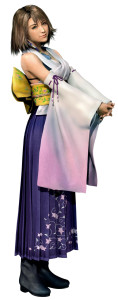
Summoner extraordinaire Yuna and her merry band of guardians, led by this guy:
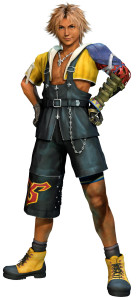
They save Spira from the unending cycle of Sin’s rebirth through the Final Summon and sacrifice…. And you know what, go read the Final Fantasy 10 wikipedia if you want the plot. Point being, Yuna in the first game is used as the fatal romantic interest for our hero. She’s still incredibly powerful and has Giant Monster beasts called Aeons at her beck and call. And through strategic use of the sphere grid you can make her your hardest hitter, which is awesome. But I’ll dedicate a post to the wonder of the FFX sphere grid another day. Narratively though Yuna has a strong resolve and is determined to meet her final fate, only to be told by her blitzball playing love interest that she’s wrong and her way of doing things are wrong and that she needs to listen to him otherwise she’ll always be wrong and die. Don’t worry though, everything she believed in was wrong anyways and only by listening to the hero does she get to star in her own sequel, but more on that in a minute.
As the driving force behind the plot, even suffering from the Damsel in Distress trope, Yuna plays a pretty typical role as the love interest, as well as the potential victim of the future, that the hero is trying to save from her ultimate need to sacrifice to herself. It should be of note that the way in which Yuna gains the voice to say no to her situation in FFX is through the mimicry of her love interest, but that’s not what this post is about, this post is about sexually objectifying powerful characters. Like so:
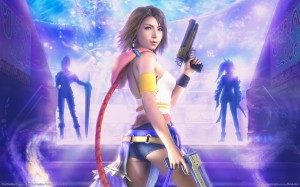
Although relatively controversial amongst Final Fantasy for its continued telling of a story people assume we’ve already heard (we haven’t), Final Fantasy X-2 did something that I thought was really cool: it allowed players to take up the mantle of Yuna, sphere hunter extraordinaire for the Gullwings. Along with your two sidekicks: the tough as nails Paine and sugar candy ADD-thief Rikku, Yuna would trek across Spira seeking adventure and eventually saving the world again. The game is very reminiscent to a campy version of Charlie’s Angels, only with more magic and action and Dark Knight smashy goodness.
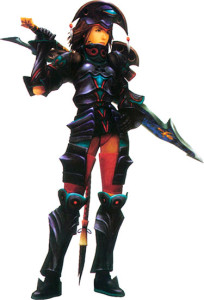
Yuna is the unequivocal leader this time around, following no one but her own path. This is her story.

But make note in her change of appearance. Like with most FF designs, she has some extraneous bits to her costume that don’t make a whole lot of sense, the feathered hip cape comes to mind, but also make note of the highlighting of her secondary sex characteristics. While there is no doubt that her previous summoner costume does the same, it can be argued that the entire thing is a little more conservative, while still maintaining her femininity. This of course is meant to reinforce Yuna’s role in FFX, which is of the pure and naive love interest, who is locked into her fate and must be saved by forces external to herself, ie. Tidus (and the Gang)
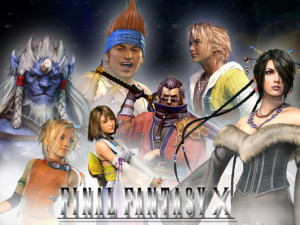
Conversely in FFX-2, when Yuna becomes the driving force behind the plot, her breasts, hips and butt are displayed frequently and becomes a focus for the bulk of the costumes she dons to do battle.
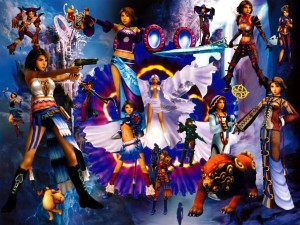
The point being driven home is that Yuna in FFX is under pressures and restrictions and needs something apart from herself to surmount obstacles, this is represented by her feminine and pure character design. In FFX-2 Yuna has all the agency in the world and can dictate to her airship captain where to go at any point, but in doing so she needs to be sexually attractive, explicitly so.
What I’m trying to get at here is a thread common in a lot of games (note how I did not say all) that include kickass lady protagonists: That in order to be given the agency to be a hero in their own right, no matter how powerful, a female character before anything else, must first be attractive. Designers start creating these women based on their appearance first rather than what personality traits or skills she has in order to succeed in the game world she’s been placed in. Instead what gets made is a relatively homogeneous interpretation on what is attractive, thus what will sell. For you see the instinct that persists still, in 2013, is that only young men buy games and thus if you simply have to create a game with a female character she better be pretty to look at, to give the players some eye candy to oogle throughout play.
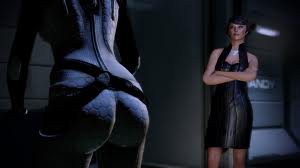
Now I’m not advocating for completely taking sex appeal out of games, I’m just wishing for more diverse representations of attractive women, none of that normative large breasted, large but not too large hipped and butted woman that we persistently see. I mean, we’ve been playing as the same overweight, mustachioed plumber for years, and yet representations of women always fall into the same formula: Normative Body ideal + Nice Face + Great Hair that never tangles = Sometimes a personality. Also, I think it would be great if developers could acknowledge, just for a second, that there might be something problematic with lovingly showcasing a butt model they created on a female character who’s in the middle of kicking ass or expressing some sort of emotion.
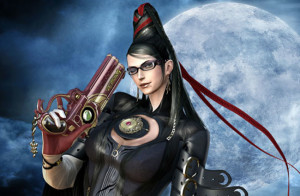
I also don’t believe that there’s a truly balanced way to go about correcting this problem. For instance, I personally get conflicted over the character Bayonetta. She’s a total badass and one of the strongest characters in her game. She also happens to destroy the field of battle using high kicks, stripper pole moves and divesting herself of her hair armor (don’t ask) to unleash devastating combos. She’s a character granted agency through her sexuality, who is very blase about others perceptions of her and who is only like this due to the predominantly male designers who shaped her into a character. She’s badass, she’s attractive and she also suffers from the strange (you’d never see them used on a male) camera angles that highlight her “assets”.
I can see why she is problematic but I think she’s also really cool. Bayonetta 2 recently had a trailer during this years E3 where she debuted a new short haircut and some fight scenes that were displayed. Like this:
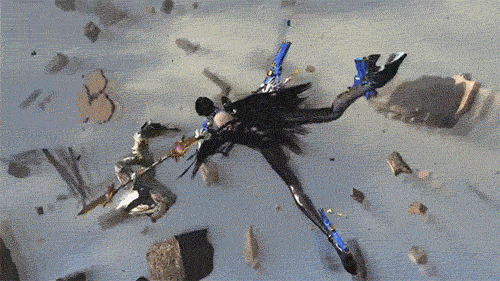
…. Uhm. Wait, what was her big reveal like?
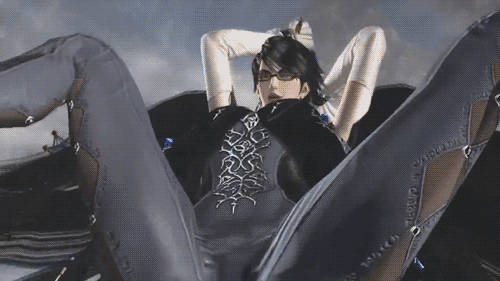
Urk! Right in the feminism.
Okay. So barring my new perception of a once conflictingly beloved character, here’s a couple of articles discussing further the dichotomy between female empowerment and objectification using sexuality. They’re great reads and I highly recommend them.
Empowerment/Sexism: Figuring Female Sexual Agency in Contemporary Advertising by Rosalind Gill
Sexual Objectification of Women: Advances to Theory and Research by Dawn Szymanski, Lauren Moffitt & Erika Carr
And if you’re looking for some games that allow you to at least create diverse representations of female body types take a look at the Saints Row series (except the first), Dragon’s Dogma and the Sims. If you have any other recommendations I’d love to hear about it!
9 Comments
Comments are closed.
I was trying to think of JRPGs that are a good example of this, and then I thought of this: http://ca.ign.com/articles/2013/05/02/fire-emblem-dlc-censored-in-north-america
Do you think there is also censoring of women’s bodies to disempower them? Thoughts?
It makes me think. I wonder if the censorship angle has to do with the posing of Tharja in the picture provided? It’s from a low angle and from behind with her looking slightly surprised as if to imply a voyeuristic happenstance. Which I can see why that might perplex the North American audience, especially given that none of the other cast has the same sort of angle going on in their photos.
(Although the discrepancy between the presentation of Gaius’ http://images.wikia.com/fireemblem/images/4/4d/Guire_Beach_DLC.png swimsuit and say, Cordelia’s http://www.technologytell.com/gaming/files/2013/05/cordelia-fire-emblem-dlc.png is annoying me)
But on the flip side, the censorship implies that women’s bodies are not fit or at least moral to be consumed. Which is disconcerting.
Well written! I find it really interesting that this years biggest titles (The last of us, bioshock infinite) showcase real female protagonists, dressed appropriately and displaying real emotional development. I find this onteresting because the guys are the ones loving these games. I think its time that development companies realize that rounding out female characters enhances gameplay for everyone, and at the heart of it, thats what the majority of gamers are now after.
I’m not necessarily calling for an end to attractive or sexy outfits on female characters but I do agree that women need further fleshing out, rather then being limited to the homogeneous sexy heroine. I think modesty and sexiness can coexist in the gaming world, women just need better and more diverse representations in games, especially given the the statistic that women make up 49% of game playing consumers.
There’s more to women then their appearance and when game developers start consistently representing this I think I’ll be content.
While you do make some really good points here, I object to the assertion that Yuna’s decisions in X are wholly a mimicry of what her love interest does. While he definitely influences her thought processes (which he naturally would, as she does not exist in a vacuum), she rejects his multiple requests to give up her pilgrimage, even telling him to his face that as much as this is his story, it’s ALSO hers. She is not willing to give up until Yunalesca tells her that the Final Summoning won’t work, at which point she chooses to reject it because it won’t help her attain her ultimate goal. Saying that her behavior is entirely a mimicry of his does a disservice to her, and assumes that just because she agrees with him, she must have done so without any actual thought, which is itself an unfortunate assertion and discounts the character.
That’s a really good point Meg. I’ll admit when I was thinking about Yuna’s characterization in game, it was the initial interactions with her, kind of disregarding the quiet strength she portrays, especially in the end game. More what I was trying to get at by presenting Yuna in this article was pointing out how the only way she could become the hero of her own story is by objectifying her and her companions sexually in FFX-2. Which is ironic as you pointed that in FFX Yuna tell Tidus that this is also her story. My argument is based around the fact that if it were also truly “her story” the developers wouldn’t feel the need to change her physical appearance to make her more engaging. I by no means intended to devalue the strength of her character or her will and determination. Not too mention the heavy hitter she is when you give her some black magic spells. Thank you for reminding me of that Meg!
I may habe misread or misunderstood some of this regarding yuna so just humour me…
I get the feeling when playimg the game that it os yuna’s choice to dress the way she does in ffx2, not a designers choice. (I’m aware she is designed but I mean to say I don’t feel she is designed specifically for sexually pleasure). My first thought when I saw her was that she felt free or everything. She just had to die to sabe spira. Had years of religous training, wore special garments, had to do and say certain things. I feel like it is her way of shaking off the authority, the heavy dress, the stress on her shoulders and just being free.
I see it as a representation of her relief and care free attitude, she can finally be a girl, wear her hair how she wants, fall in love, see the world. She is just being bubbly.
I don’t think she needs to be attractive to be powerful. They all look up to her and want to help her find answers. Paine is just as powerful and she’s not bery feminine. Yuna doesn’t need to be “sexy” it just happens to be that Brother likes her. She doesn’t give off the vibe to me that she needs to be hot, when Brother flirts with her she just gets embaressed or laughs it off. She doesn’t start stripping and say “take me to zanarkand. ..”
I kind of get what you are saying though, games do feel the female has to look and act a certain way. But with yuna I just feel she is being freed from her boring life, not be exploited. :/
Hey Sim, what I was kind of trying to get at in this article was about the issue of designer choices when creating female characters. A lot of the examples I used throughout the article are women who are powerful, strong, dangerous and who all happen to be, by popular media standards, traditionally attractive.
I do agree with your perspective on the narrative in regards to Yuna’s change in FFX-2 and I agree that it makes sense that her personal style would indicate further freedom from what she had in FFX, where she felt her fate was sealed as a summoner. What I was getting at by bringing up Yuna is that even in the trappings of serving the narrative, someone in the real world that you and I exist in decided that Yuna was going to wear short shorts and blousy tank top with a boob window to imply freedom. As I mentioned in the article she was given autonomy in the second game but only after she started dressing a certain way, which is where I made the association of Yuna being liberated by becoming more outwardly sexually available based on her personal style. There would be nothing wrong with this if FFX-2 existed in a vacuum. Unfortunately Yuna is part of a long pattern in the game industry of dressing women certain ways so they are deemed less threatening or more appealing even if they are super powerful warriors.
My big issue with the whole thing is basically that I’m tired of women only getting to be sexy in games, or pretty or small and shapely and curvaceous and skinny and so many other things limited to their appearance. There are whole categories of women who are underrepresented in games and that needs to stop. I look forward to the day where games represent as many diverse body types and personalities for women as they do for men. Thanks for commenting!
Some angles look better for women than for men. The sexual features of a woman are a powerful weapon of seduction both for her private romantic aspirations and for commercial purposes.
You won’t find as many people willing to buy a game displaying obese heroines dressed as monks as you will find if the game shows voluptuous heroines in bikini like outfits.